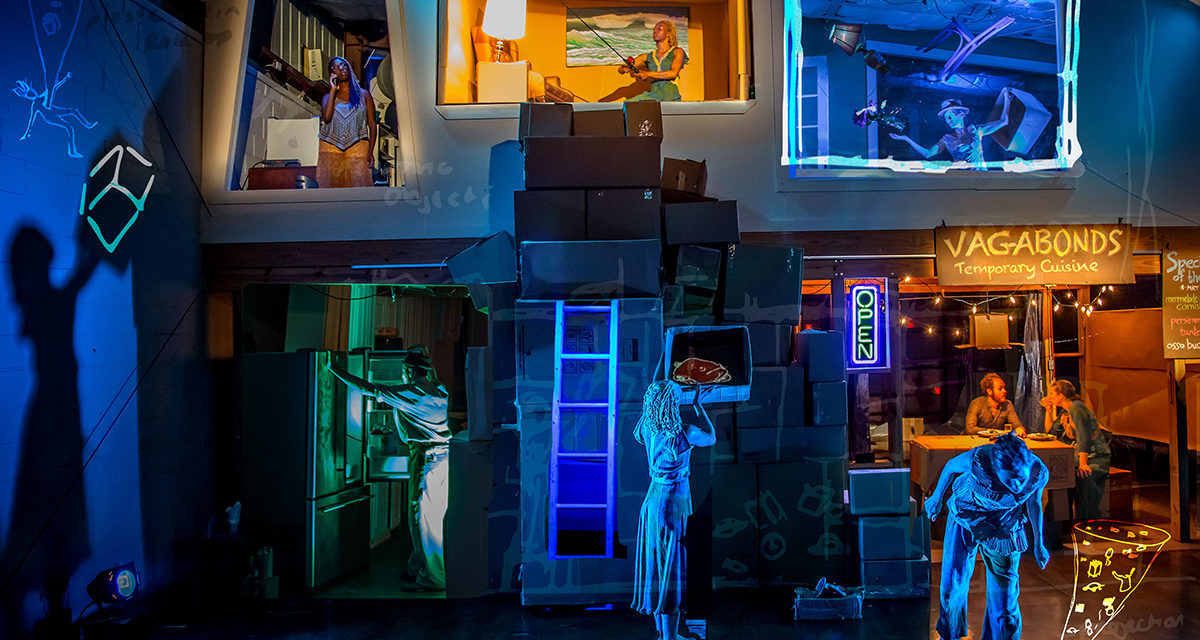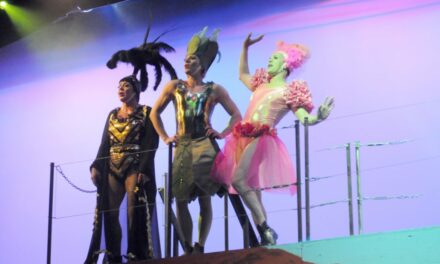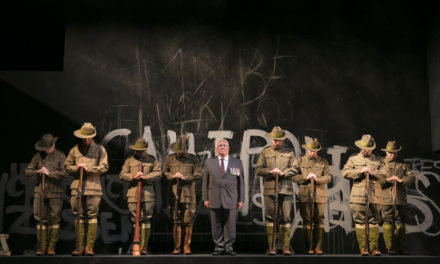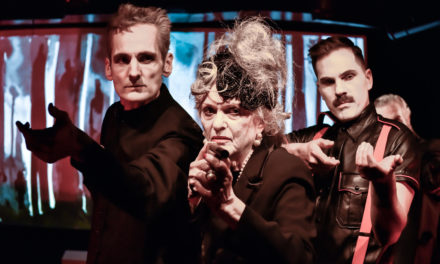Irondale Ensemble Project, a self-defined “think tank” in Brooklyn’s bustling Fort Greene nabe is currently home to a vivid, experimental production called Sea Of Common Catastrophe.
Sea is the creation of New Orleans-based director and designer Jeff Becker, whose background in sculpture is evident in the intricate scenic design that is the highlight of this original, inventive production. Becker is the co-founder of Catapult, a performance lab devoted to design-driven theater.
One is greeted upon arrival at the upstairs Irondale auditorium, which resembles a high school gymnasium, by a phalanx of boxy set pieces which later spring open to reveal a series of tableaux that help transport the audience into the various scenes of the performance. Among the evening’s most memorable set pieces are a fishing interlude on the makeshift upper level of the stage and a sort of cabin or cottage set directly below it.
With such elaborate attention paid to the visual component of the evening, it’s inevitable that words play a supporting role in such a production. The text itself is solid and effective yet there is a decided lack of realistic dialogue, another clear indication of the experimental edict of the performance.
Thankfully, Sea delivers on various fronts, including solid acting, lovely songs that are sung convincingly, and nuanced blocking. Were the show merely a display of visual dexterity, it would be a memorable evening. That these extra-design components of the performance are effective makes for a full evening of quirky, ultimately meaningful, theatre.
In lieu of a “written by” credit in the playbill, there is a “created and performed by” mention of four of the five actors onstage. In an apparent nod to hip-hop sampling, Gabriel Garçía Márquez is credited under “text quotations.” These explicit components of Sea help set it squarely in the context of devised theater. In essence, this is a collaborative creation, both a refreshingly novel and somewhat underemployed construct in the context of the commercial confines of the current New York theater climate.
In addition to Becker, much credit is due to director Janis Russell, who is ably assisted by assistant director/choreographer/performer Jeffrey Gunshol. Additional kudos are due to video designers Courtney Egan and Lucien Levi, lighting designer Evan Spigelman, and music director/sound designer Sean LaRocca. A commanding chorus, stationed balcony-level, downstage left, adds yet another sensorial dimension to the performance.
Alas, costume designer Laura Faye Sirkin-Brown is responsible for the most memorable image of the evening, an illuminated scuba diving mask that appears late in the performance. In the absence of a set design credit, one must conclude that hyphenate Becker had his hand in the design of the multi-faceted scenery.
The director’s note in the playbill helps contextualize a pervasive if at times ephemeral theme of Sea, that of displacement, specifically as it relates to gentrification. The evening’s chief strength, of emphasizing visuals to convey plot, is both its most distinctive trait and the cause of an occasional lapse into incoherence. That is, it’s not always clear how the various scenes relate to or crescendo towards a more traditional climax, yet Sea does rise to a palpable crest of catharsis.
It’s possible that Becker’s intent is to subvert the conventions of narrative or text-based performance in lieu of sublime imagery, songs, and other elements employed in a non-traditional manner to evoke a uniquely original form of theatrical transcendence. That he and his team are largely successful makes one yearn for more work from the Sea team.
Sea offers a delightful diversion that would be at home uptown at a space such as the New Victory Theater, an international venue thick with visually ornate performances that appeal to teens as well as adults. Sea is a dynamic evening of non-traditional theater festooned with rich imagery sure to delight the sophisticated theatergoer. In its unwavering commitment to experimental theater, it suggests a particularly Southern US version of the sort of innovation pioneered by the likes of SITI Company and its descendants.
Sea Of Common Catastrophe is playing at the Irondale Center, 85 South Oxford Street in Brooklyn.
This post was written by the author in their personal capacity.The opinions expressed in this article are the author’s own and do not reflect the view of The Theatre Times, their staff or collaborators.
This post was written by Jack Wernick.
The views expressed here belong to the author and do not necessarily reflect our views and opinions.


















